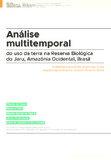Análise multitemporal do uso da terra na Reserva Biológica do Jaru, Amazônia Ocidental, Brasil

View/
Date
2020-12-02Author
Palabras Clave
sensoriamento remoto, uso e ocupação do solo, plano de manejo, conservação da naturezaland use and occupation, remote sensing, management plan, nature conservation
Metadata
Show full item recordAbstract
As pressões sofridas em áreas protegidas são geralmente causadas por seu entorno, e seu monitoramento pode auxiliar em ações de conservação da natureza. Técnicas de sensoriamento remoto e geoprocessamento tornam-se ferramentas essenciais no monitoramento da dinâmica de uso e ocupação do solo. Assim, o objetivo do estudo
foi realizar uma análise do uso e ocupação do interior e do entorno da Reserva Biológica do Jaru, caracterizando as principais mudanças ocorridas na paisagem. O estudo foi realizado usando o programa SPRING. Os maiores impactos foram observados na área de entorno da reserva onde durante o período acumulado (1984-2016) foi registrada uma perda de mais de 20% de sua cobertura florestal e o aumento significativo da classe agropecuária que, no ano da criação da floresta a unidade representava apenas 2% do total. As entidades gestoras têm dificuldade em garantir a proteção da unidade e, até o momento, nenhuma limitação foi imposta ao uso de recursos naturais nas zonas de amortecimento.
Collections
Información Adicional
| Otros Títulos | Multitemporal analysis of land use in the Jaru Biological Reserve, western Amazon, Brazil |
| Correo Electrónico | wesley.souza@ifac.edu.br emanuel@unir.br rgaguiar@unir.br jhony@unir.br edyrosell@unir.br |
| ISSN | 1012-1617 |
| ISSN Electrónico | 2244-8853 |
| Resumen en otro Idioma | The pressures suffered in protected areas are generally caused by their surroundings, and their monitoring can assist in nature conservation actions. Techniques of remote sensing and geoprocessing become essential tools in the monitoring of the use dynamics and land occupation. Thus, the objective of the study was to carry out an analysis of the use and occupation of the internal as well as of the surrounding areas of the Biological Reserve of Jaru, characterizing the main changes occurring in the landscape. The study was carried out by using the SPRING program. The biggest impacts were observed in the surrounding area of the reserve where, during the accumulated period (1984 -2016), there was a loss of more than 20% of its forest cover that was registered plus a significant increase of the farming class that, back in the year of the unit creation, accounted only 2% of the total. The management bodies have difficulty in ensuring the protection of the unit, and so far, no limitation was imposed to the use of natural resources in the buffer zones. |
| Colación | 430-441 |
| Periodicidad | Semestral |
| Página Web | http://www.saber.ula.ve/regeoven/ |
| País | Venezuela |
| Institución | Universidad de Los Andes |
| Sección | Revista Geográfica Venezolana: |





